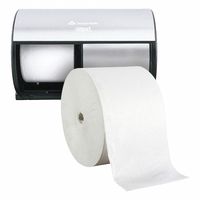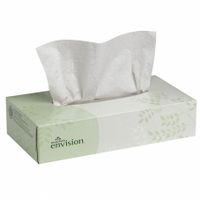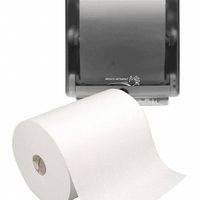Call +(254) 703 030 000 / 751 483 999 / 721 704 777
- Home
- Cleaning And Janitorial
- Paper Products Dispensers
.....Read More
Frequently Asked Questions
What are the benefits of using paper products in public facilities?
Using paper products in public facilities offers several key benefits, primarily concerning hygiene, convenience, and environmental impact.
From a hygiene perspective, paper products, such as paper towels and toilet seat covers, are single-use, which significantly reduces the risk of germ transmission compared to reusable alternatives like cloth towels. This is particularly crucial in high-traffic public areas where maintaining cleanliness is paramount to public health.
Convenience is another major advantage. Paper products are readily available, easy to dispense, and require minimal maintenance from facility staff. Users can quickly and efficiently dry their hands or cover a toilet seat, contributing to a smoother and more pleasant experience.
Environmentally, many paper products today are made from recycled content or sustainably sourced materials, and they are often biodegradable or compostable. This can reduce the environmental footprint compared to the energy and water consumption associated with laundering reusable items. Furthermore, proper disposal of paper products can be managed through recycling programs, contributing to waste reduction efforts.
How do paper towels compare to cloth towels in terms of hygiene?
Please tell me what you would like me to elaborate on.
What is the environmental impact of disposable paper products?
Disposable paper products have a significant environmental impact throughout their lifecycle, from raw material extraction to disposal. The production process involves logging forests, which leads to deforestation, habitat loss, and reduced biodiversity. This also contributes to climate change as trees absorb carbon dioxide. The manufacturing of paper products is also energy-intensive and consumes large amounts of water, leading to increased greenhouse gas emissions and water pollution from chemicals used in pulping and bleaching.
Once used, disposable paper products often end up in landfills, where they contribute to methane emissions as they decompose in anaerobic conditions. While some paper products can be recycled, a substantial portion is not, due to contamination or lack of recycling infrastructure. Even recycling has an environmental footprint, requiring energy and water. The demand for disposable paper products encourages a linear economy model, where resources are extracted, used, and discarded, rather than reused or recycled. This unsustainable model depletes natural resources and increases waste generation.
How can businesses reduce waste when using paper products?
To reduce waste from paper products, businesses can implement several strategies. Firstly, prioritize digital solutions whenever possible, such as online invoicing, digital contracts, and cloud-based document sharing, to minimize the need for physical printouts. When printing is necessary, print double-sided and use recycled paper. Encourage employees to use reusable mugs and dishware instead of disposable paper cups and plates. Implement a robust recycling program for all paper waste, ensuring proper sorting and collection. Consider composting shredded paper or using it as packing material. Finally, educate employees on the importance of reducing paper waste and provide clear guidelines for sustainable practices.
What are the best practices for using paper products in restrooms?
To ensure hygiene, efficiency, and sustainability, best practices for using paper products in restrooms include selecting appropriate products like high-capacity rolls to reduce refills and high-quality paper to minimize waste. Proper dispenser placement at convenient, accessible heights prevents overuse and facilitates easy access. Regular monitoring of paper levels helps maintain stock and prevents shortages, ensuring a continuous supply. User education through signage encourages responsible use, reducing waste and promoting cleanliness. Proper waste disposal, including clearly marked bins for used paper products, helps maintain a tidy and hygienic environment.
How do automatic dispensers for paper products work?
Automatic dispensers for paper products, such as paper towel dispensers or toilet paper dispensers, typically work using a sensor-based or mechanical system to dispense paper without the need for manual contact with the roll itself.
Sensor-based dispensers use infrared or motion sensors to detect a hand placed near the dispensing area. When a hand is detected, a motor activates, rotating a roller or series of rollers that feed a pre-determined length of paper out of the dispenser. Some advanced models may have adjustable settings for the length of paper dispensed. These systems are often powered by batteries or an AC adapter.
Mechanical or pull-and-tear dispensers operate without electricity. When a user pulls on the exposed end of the paper, an internal mechanism releases a set amount of paper. Often, this involves a "present-and-cut" system where pulling on the paper causes a new sheet to be presented, and a subsequent pull or a tearing motion severs the presented sheet while preparing the next one.
The design of these dispensers aims to improve hygiene by reducing touchpoints and to control consumption by dispensing a consistent amount of paper, thereby reducing waste.
What are the differences between various types of paper towels?
Paper towels differ mainly in their material, ply, and absorbency. Material-wise, most are made from wood pulp, but some incorporate recycled fibers or bamboo for eco-friendliness. Ply refers to the number of layers; single-ply towels are thinner and less absorbent, suitable for light spills, while two-ply or even three-ply offer greater thickness and absorbency for tougher messes. Absorbency is also affected by embossing patterns, which create air pockets to trap liquid, and wet strength, which is enhanced by chemicals to prevent tearing when wet. Some paper towels are also designed for specific uses, such as strong, textured options for cleaning, or softer, more absorbent ones for kitchen tasks.
How are facial tissues different from toilet paper?
Facial tissues and toilet paper are both made from paper pulp, but they are designed for different purposes, leading to key distinctions in their composition and properties.
Facial tissues, primarily used for nasal hygiene, are generally softer and more absorbent, often infused with lotions or emollients to be gentle on the skin. They are typically made from virgin paper pulp and are designed to be strong enough to resist tearing during use but also soft for comfort.
Toilet paper, on the other hand, is specifically engineered to break down easily when wet. This is crucial for plumbing systems, as toilet paper that doesn't disintegrate can cause clogs. It's often made from a blend of virgin and recycled fibers and is designed to be strong enough for its intended use but fragile enough to dissolve in water. Unlike facial tissues, toilet paper is not meant to be soft to the touch or infused with lotions, as these characteristics would hinder its dissolvability. In summary, facial tissues prioritize softness and absorbency for skin contact, while toilet paper prioritizes rapid disintegration for plumbing safety.
What are the advantages of using door handle tissues?
Using door handle tissues offers several key advantages, primarily centered around hygiene and convenience. In public or shared spaces, door handles are high-touch surfaces that can harbor a multitude of germs, including bacteria and viruses. By using a tissue to open a door, individuals create a physical barrier between their hands and these potentially contaminated surfaces, significantly reducing the risk of germ transmission. This is particularly beneficial during cold and flu season or in environments like restrooms, offices, and healthcare facilities where cleanliness is paramount.
From a convenience standpoint, door handle tissues provide an immediate and accessible solution for maintaining hand hygiene without requiring frequent trips to a handwashing station or relying on hand sanitizer. They can be readily available near doorways, encouraging users to practice safer habits. Furthermore, the disposable nature of these tissues means that any contaminants are contained and discarded, preventing further spread. This simple yet effective practice contributes to a healthier environment for everyone, minimizing the spread of illnesses and promoting better public health.
How can paper products improve sanitation in medical facilities?
Paper products significantly enhance sanitation in medical facilities by offering single-use solutions that minimize germ transmission. Items like disposable paper towels, examination table coverings, and bed linens prevent cross-contamination, a critical concern in healthcare settings. Unlike reusable cloth items, which require rigorous laundering and can still harbor pathogens if not processed correctly, paper products are discarded after each use, effectively breaking the chain of infection.
Hand hygiene is a cornerstone of infection control, and paper towels play a vital role. They provide a clean, dry surface for hands after washing, which is more effective at removing bacteria than air dryers. Disposable tissues and wipes also facilitate quick and easy cleanup of spills and bodily fluids, further reducing the spread of contaminants.
Moreover, the use of disposable paper products reduces the workload associated with laundry and sterilization, allowing staff to focus more on patient care. This efficiency, combined with the inherent hygienic benefits, makes paper products an indispensable component of infection prevention strategies in medical environments. Their ease of disposal and single-use nature make them a simple yet powerful tool in maintaining a sterile and safe environment for both patients and healthcare workers.




